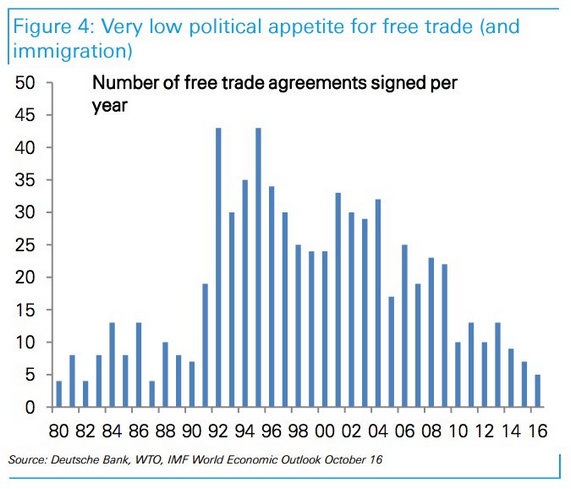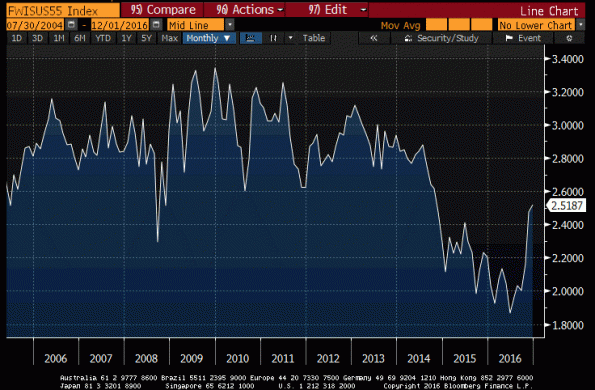Whatever else the election of Donald Trump to be president of the United States has meant, it has meant a lot of excitement in precincts that worry about inflation. This is usually attributed, among the chattering classes, to the faster growth expected if Mr. Trump’s expressed preference for tax cuts and spending increases obtains. However, since growth doesn’t cause inflation, that isn’t the part of a Trump presidency that concerns me with respect to a continuing rise in inflation.
In our latest Quarterly Inflation Outlook, I wrote a short piece on the significance of the de-globalization movement for inflation. That is an area where, if the president-elect delivers on his promises, a lot of damage could be done in the growth/inflation tradeoff. I have written before about how a big part of the reason for the generous growth/inflation tradeoff of the 1990s was the rapid globalization of many industries following the end of the Cold War. Deutsche Bank (NYSE:DB) recently produced a research piece that contained the following chart (Source: as cited).
This chart is the “smoking gun” that supports this version of events, in terms of why the inflation dynamic shifted in the early 1990s. Free trade helped to restrain prices in certain goods (apparel is a great example – prices are essentially unchanged over the last 25 years), by allowing the possibility of significant cost savings on production.
The flip side of a cost savings on production, though, is a loss of domestic manufacturing jobs; it is this loss that Mr. Trump took productive advantage of. If Mr. Trump moves to increase tariffs and other barriers to trade, and to reverse some of the globalization trend that has driven lower prices for the last quarter-century, it is potentially very negative news for inflation. While there was some evidence that the globalization dividend was beginning to get ‘tapped out’ as all of the low-hanging fruit had been harvested – and such a development would cause inflation to be higher than otherwise it would have been – I had not expected the possibility of a reversal of the globalization dividend except as a possible and minor side-effect of tensions with Russia over the Ukraine, or the effect the Syrian refugee problem could have on open borders. The election of Mr. Trump, however, creates the very real possibility that the reversal of this dividend might be a direct consequence of conscious policy choices.
I don’t think that’s the main reason that people are worried about inflation, though. Today, one contributor is the news that OPEC actually agreed to cut production, in January, and that some non-OPEC producers agreed to an additional cut. U.S. shale oil producers are clicking their heels in delight, because oil prices were already high enough that production was increasing again and they are more than happy to take more market share back. Oil prices are up about 15% since the announcement.
But that’s near-term, and I don’t expect the oil rally has legs much beyond current levels. Break-evens have been rallying, though, for weeks. Some of it isn’t related to Trump at all but to other initiatives. One correspondent of mine, who owns an office-cleaning business, sent me this note today:
Think of you often lately as I’m on the front line out here of the “instant” 25% increase in min wage. Voters decided to move min wage out here from 8.05 to $10 jan 1. Anyone close to 10/hr is looking for a big raise. You want to talk about fast dollars, hand a janitor a 25% pay bump and watch the money move. Big inflation numbers pending from the southwest. I’m passing some through but market is understandably reacting slower than the legislation.
Those increases will definitely increase measured inflation further, though by a lot less than it increases my friend’s costs. Again, it’s an arrow pointing the wrong way for inflation. And, really, there aren’t many pointing the right way. M2 growth continues to accelerate; it is now at 7.8% y/y. That is too fast for price stability, especially as rates rise.
All of these arrows add up to substantial moves in inflation break-evens. 10-year breaks are up 55bps since September and 30bps since the election. Ten-year inflation expectations as measured more accurately by inflation swaps are now at 2.33%. Almost all of that rise has been in expectations for core inflation. The oft-watched 5y5y forward inflation (which takes us away from that part of the curve which is most impacted by energy movements) is above 2.5% again and, while still below the “normal” 2.75%-3.25% range, is at 2-year highs (see Chart, source Bloomberg).
So what is an investor to do – other than to study, which there is an excellent opportunity to do for the next three Mondays with a series of educational webinars I am conducting (see details below)? There are a few good answers. At 0.46%, 10-year TIPS still represent a poor real return but a guaranteed positive 1/2% real return beats what is available from many risky assets right now. Commodities remain cheap, although less so. You can invest in a company that specializes in inflation, if you are an accredited investor: Enduring Investments is raising a small amount of money for the management company in a 506(c) offering and is still taking subscriptions. Unfortunately, it is difficult to own inflation expectations directly – and in any event, the easy money there has been made.
What you don’t want to do if you are worried about inflation is own stocks as a “hedge.” Multiples move inversely with inflation.
Unlike prior equity-market rallies, I understand this one. It is plausible to me that a very business-friendly President, who cuts corporate and personal taxes and reduces regulatory burdens, might be good for corporate earnings and even for the economic growth rate (although the bad things coming on trade will blunt some of that). But before getting too ebullient about the potential for higher corporate earnings, consider this: if Trump is business-friendly, then surely the opposite must be said about President Obama who did essentially the reverse. But what happened to equities? They tripled over his eight years (perhaps they “only” doubled, depending on when you measure from). That’s because lower interest rates and the Fed’s removal of safe securities in search of a stimulus from the “portfolio balance channel” caused equity multiples to expand drastically. So, valuations went from low, to extremely high. Multiples matter a lot, and right now even if you think corporate earnings over the next four years might be stronger than over the last four you still have to confront the fact that multiples are more likely to move in reverse. In short: if stocks could triple under Obama, there is no reason on earth they can’t halve under a “business-friendly” President. That’s not a prediction. (But here is one: equities four years from now will be no more than 20% higher than they are now, and might well be lower.)
Also, remember Ronald Reagan? He who created the great bull market of the 1980s? Well, stocks rallied the November he was elected, too. The S&P 500 closed November 1980 at 140.52. Over the next 20 months, the index lost 24%. It wasn’t until almost 1983 before Reagan had a bull market on his hands.


